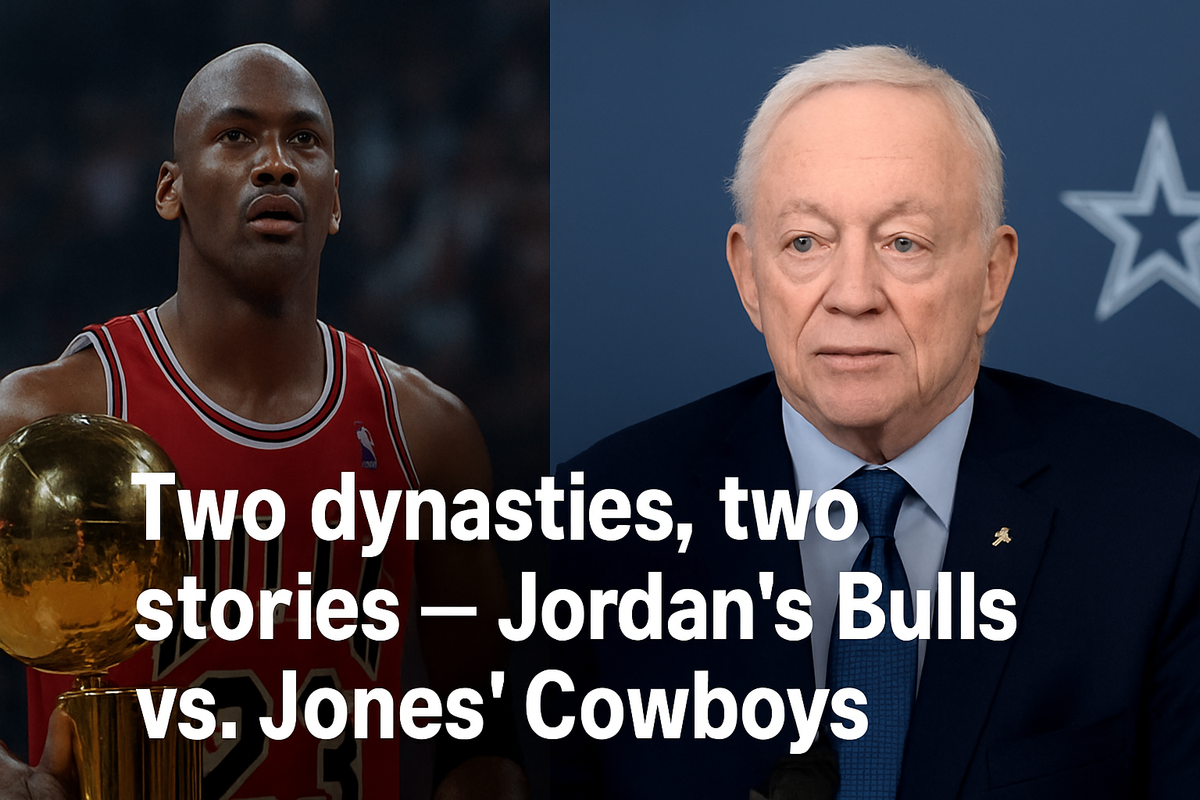Netflix Documentary vs. The Last Dance: A Deeper Look at Sports Storytelling
Netflix’s America’s Team: The Gambler and His Cowboys contrasts sharply with The Last Dance, exposing raw chaos, ego, and scandal behind the Dallas Cowboys’ dynasty offering a darker, unfiltered sports documentary experience.

Sports documentaries have always been more than just about the games they’re about myth-making. They take moments we vaguely remember and stitch them together into a narrative that defines how future generations will remember a team, a player, or an era. In 2020, ESPN and Netflix’s The Last Dance redefined what a sports docuseries could be. It wasn’t just a chronicle of Michael Jordan and the Chicago Bulls dynasty it was a cultural event, a binge-worthy spectacle that captivated sports fans and casual viewers alike.
Fast forward to 2025, and Netflix is at it again, but this time with a very different beast: America’s Team: The Gambler and His Cowboys. This documentary dissects the rise and fall of Jerry Jones’ Dallas Cowboys empire during the 1990s a team that embodied both glory and chaos, a perfect mix of triumph and self-destruction. Unlike The Last Dance, which painted Jordan and his Bulls as near-mythical figures, Netflix’s Cowboys doc dares to strip the veneer and lean into the raw, unfiltered messiness of sports, money, ego, and power.
So how does The Gambler and His Cowboys stack up against The Last Dance? Let’s dig in.
Setting the Stage: The Last Dance Effect
When The Last Dance dropped in April 2020, the world was in the middle of a global shutdown. Sports had stopped, stadiums were empty, and fans were desperate for any glimpse of competition. The docuseries arrived like an oasis. Beyond timing, it was a masterclass in storytelling cutting between Jordan’s rookie year, the Bulls’ dynastic runs, and the team’s final season in 1998.
It wasn’t just about basketball. It was about legacy, personality clashes, corporate sponsorships, and the pressures of being a global icon. The editing was sleek, the soundtrack electric, and the interviews carefully constructed to elevate Jordan’s mystique. Even when he was criticized, Jordan seemed untouchable his dominance framed as inevitable destiny.
The key takeaway? The Last Dance was as much a brand campaign as a documentary. Jordan was involved in its production, which meant the narrative leaned heavily in his favor. Critics often noted that while it was compelling, it wasn’t exactly objective. It was a celebration, not an exposé.
Enter America’s Team: The Gambler and His Cowboys
Netflix’s Cowboys documentary arrives with a different mission. Instead of polishing legacies, it rips them open. Jerry Jones, the oil-tycoon-turned-NFL-owner, is cast not as a flawless visionary but as a reckless gambler who both built and broke his empire.
The Cowboys of the 1990s were the NFL’s most dominant franchise. With Troy Aikman, Emmitt Smith, and Michael Irvin leading the charge, the team won three Super Bowls in four years. But alongside that dominance came scandal, ego wars, and a spectacular collapse.
What makes this documentary different is its refusal to sanitize. It doesn’t gloss over the cocaine scandals, the stripper parties, or the internal feuds between Jones and legendary coach Jimmy Johnson. It portrays the Cowboys not as a dynasty of destiny but as a powder keg of talent, money, and dysfunction that eventually exploded.
Storytelling Styles: Myth vs. Mess
The most striking difference between The Last Dance and The Gambler and His Cowboys is the tone of storytelling.
- The Cowboys Doc: Chaotic, raw, and intentionally messy just like the team it covers. Instead of linear heroism, we get sharp edges: addiction, betrayal, excess, and power struggles. It feels less like a highlight reel and more like a true-crime doc set in the sports world.
The Last Dance: Polished, cinematic, carefully designed to preserve Jordan’s aura. The editing often placed him as the center of gravity, with every subplot orbiting his greatness.

In short, The Last Dance mythologizes. The Gambler and His Cowboys humanizes.
Characters in the Spotlight
Michael Jordan vs. Jerry Jones
Jordan was the sun around which The Last Dance revolved. His competitiveness, his obsession, and his sheer dominance made him both hero and anti-hero. The doc painted him as a man consumed by greatness, whose flaws (bullying teammates, gambling) were footnotes to his success.
Jerry Jones, on the other hand, emerges in the Cowboys doc as the central figure but not in a flattering way. He is portrayed as both mastermind and saboteur: the man who bought the Cowboys in 1989, hired Jimmy Johnson, and built a dynasty but whose ego and appetite for control eventually fractured the empire. Unlike Jordan, Jones doesn’t get to control the narrative. He’s shown as brilliant but flawed, charming but reckless.

Supporting Casts
- The Last Dance gave us Scottie Pippen, Dennis Rodman, Steve Kerr, and Phil Jackson each adding layers to the Bulls dynasty. Yet, the storytelling always pulled back to Jordan.
- The Cowboys Doc spreads the focus more evenly. Troy Aikman’s leadership, Michael Irvin’s controversies, Emmitt Smith’s brilliance, and Johnson’s clashes with Jones all share center stage. The Cowboys weren’t one man they were a collective circus of personalities, each with their own demons.
This ensemble storytelling makes the Cowboys doc feel more democratic, less worshipful.
Themes: Glory vs. Excess
Both documentaries capture the pinnacle of American sports, but their themes diverge:
- The Last Dance: Greatness requires sacrifice. Jordan’s obsession, his ruthless drive, and his single-minded pursuit of winning define the narrative. The cost is emotional, but the result is immortality.
The Cowboys Doc: Excess is the enemy of greatness. The Cowboys weren’t undone by lack of talent they were undone by ego, scandal, and Jones’ inability to share power. The message is cautionary: dynasties collapse when self-indulgence outweighs discipline.

The Role of Time and Memory
An important distinction between the two series is how time shapes memory.
When The Last Dance aired, Jordan had been retired for nearly two decades. His legend was secure, his sneakers still sold out, and the NBA had benefited from his myth for years. The doc wasn’t about discovery it was about cementing.
The Cowboys doc, however, deals with wounds that still feel fresh. Jerry Jones is still alive and running the team. The Cowboys’ current struggles echo the dysfunction of the past. This makes the storytelling more confrontational less a celebration and more an autopsy.
Cinematic Choices
- Editing: The Last Dance used sleek cuts and high-tempo montages, often backed by hip-hop and rock tracks to amplify Jordan’s cool factor. The Gambler and His Cowboys opts for grittier editing pauses, silences, and slower pacing to emphasize chaos and dysfunction.
- Interviews: The Last Dance often staged interviews with luxurious backdrops, enhancing the sense of myth. The Cowboys doc uses rawer setups, mixing archival footage with more confrontational interviews, where ex-players and staff openly criticize each other.
- Mood: Jordan’s doc feels like a victory parade. Jones’ doc feels like a Shakespearean tragedy.
Cultural Impact
The Last Dance was a unifying cultural moment. It dropped during a sports drought, sparking memes, debates, and a resurgence of Jordan’s legacy. It reminded everyone why the 1990s Bulls were the gold standard of sports dynasties.
The Cowboys doc doesn’t aim for nostalgia it aims for confrontation. It forces fans to reckon with how a team dubbed “America’s Team” embodied not just success, but also the darker underbelly of American sports culture: excess, exploitation, and the cult of celebrity.
While The Last Dance boosted Jordan’s brand, The Gambler and His Cowboys complicates Jones’ legacy. It raises uncomfortable questions: Was he a genius owner or a self-destructive egomaniac? Was the Cowboys’ dynasty inevitable or did Jones gamble it away?
Lessons for Modern Sports
Both series offer lessons for today’s athletes, owners, and fans:
- Control of Narrative: Jordan proved that controlling your story ensures you’re remembered on your terms. Jones, by contrast, is portrayed through others’ lenses, showing how easily legacies can be reshaped.
- Team vs. Individual: The Bulls’ success was framed as Jordan lifting everyone around him. The Cowboys’ success was undone by one man’s inability to share credit.
- Myth vs. Reality: Sports documentaries can either polish legends (The Last Dance) or strip them bare (The Gambler and His Cowboys). Both approaches resonate but in very different ways.
Which Is the Better Documentary?
“Better” depends on what you’re looking for.
- If you want sleek entertainment, myth-building, and goosebump moments, The Last Dance remains unmatched. It’s the kind of documentary you rewatch when you want to feel inspired.
- If you want brutal honesty, unfiltered chaos, and a raw look at the costs of ego and excess, The Gambler and His Cowboys delivers something fresh. It’s uncomfortable, but it sticks with you.
In many ways, the two complement each other. Together, they show the two sides of sports storytelling: the glorification of greatness and the exposure of flaws.
Final Thoughts
Sports documentaries are never just about sports they’re about identity, power, culture, and memory. The Last Dance gave us the fairytale version: greatness immortalized, legacies secured. The Gambler and His Cowboys gives us the cautionary tale: greatness squandered, power corrupted.
Both are essential, but for different reasons. Jordan’s Bulls showed us the heights of obsession. Jones’ Cowboys showed us the depths of excess.
In the end, the true value of these documentaries lies not in which team was better but in how they reveal what we crave from our heroes: sometimes we want gods, and sometimes we want mortals.
And maybe, just maybe, the Cowboys documentary hits harder today because it reminds us that even “America’s Team” can fall apart not from lack of talent, but from the all-too-human flaws that no championship ring can hide.
Sources:
1. The Guardian
- Highlights the documentary’s “unflinching, raw portrayal” of the Cowboys’ dynasty and contrasts it with the more polished narrative of The Last Dance, emphasizing its depth, honesty, and confrontation of scandals and internal conflict.
The Guardian
2. Esquire
- Celebrates the docuseries for delivering “a compelling and honest look,” diving into controversies, emotional honesty, and Jerry Jones’s transformation of the Cowboys into a $5.5-billion franchise.
Esquire
3. Decider
- Offers storytelling context, describing the series’ origins, structure, and dramatic tone. It recounts Jones’s early gambles, the "Saturday Night Massacre," and how the series mirrors the swagger of 30 for 30: The U.
Decider
4. Washington Post (Opinion)
- Reflects on the ongoing legacy of Jerry Jones—his charismatic yet divisive control over the Cowboys—and juxtaposes it with the documentary’s portrayal, suggesting it borders on vanity despite its bold storytelling.




